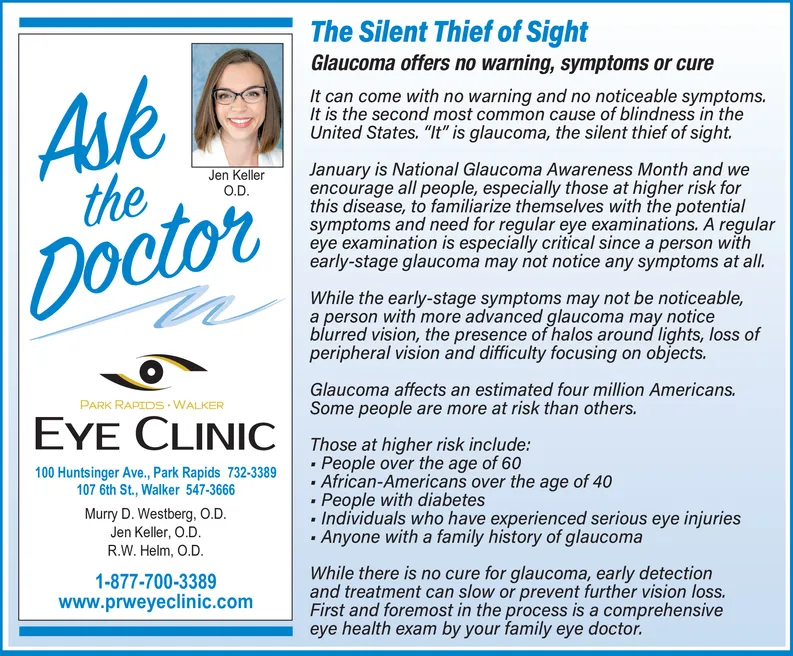Advertisement

-
Published Date
August 31, 2021This ad was originally published on this date and may contain an offer that is no longer valid. To learn more about this business and its most recent offers, click here.
Ad Text
The Silent Thief of Sight Glaucoma offers no warning, symptoms or cure Aske A the It can come with no warning and no noticeable symptoms. It is the second most common cause of blindness in the United States. "It" is glaucoma, the silent thief of sight. January is National Glaucoma Awareness Month and we encourage all people, especially those at higher risk for this disease, to familiarize themselves with the potential symptoms and need for regular eye examinations. A regular eye examination is especially critical since a person with early-stage glaucoma may not notice any symptoms at all. Jen Keller O.D. Doctor While the early-stage symptoms may not be noticeable, a person with more advanced glaucoma may notice blurred vision, the presence of halos around lights, loss of peripheral vision and difficulty focusing on objects. Glaucoma affects an estimated four million Americans. Some people are more at risk than others. PARK RAPIDS WALKER EYE CLINIC Those at higher risk include: · People over the age of 60 · African-Americans over the age of 40 People with diabetes Individuals who have experienced serious eye injuries · Anyone with a family history of glaucoma 100 Huntsinger Ave., Park Rapids 732-3389 107 6th St., Walker 547-3666 Murry D. Westberg, O.D. Jen Keller, O.D. R.W. Helm, O.D. 1-877-700-3389 www.prweyeclinic.com While there is no cure for glaucoma, early detection and treatment can slow or prevent further vision loss. First and foremost in the process is a comprehensive eye health exam by your family eye doctor. The Silent Thief of Sight Glaucoma offers no warning, symptoms or cure Aske A the It can come with no warning and no noticeable symptoms. It is the second most common cause of blindness in the United States. "It" is glaucoma, the silent thief of sight. January is National Glaucoma Awareness Month and we encourage all people, especially those at higher risk for this disease, to familiarize themselves with the potential symptoms and need for regular eye examinations. A regular eye examination is especially critical since a person with early-stage glaucoma may not notice any symptoms at all. Jen Keller O.D. Doctor While the early-stage symptoms may not be noticeable, a person with more advanced glaucoma may notice blurred vision, the presence of halos around lights, loss of peripheral vision and difficulty focusing on objects. Glaucoma affects an estimated four million Americans. Some people are more at risk than others. PARK RAPIDS WALKER EYE CLINIC Those at higher risk include: · People over the age of 60 · African-Americans over the age of 40 People with diabetes Individuals who have experienced serious eye injuries · Anyone with a family history of glaucoma 100 Huntsinger Ave., Park Rapids 732-3389 107 6th St., Walker 547-3666 Murry D. Westberg, O.D. Jen Keller, O.D. R.W. Helm, O.D. 1-877-700-3389 www.prweyeclinic.com While there is no cure for glaucoma, early detection and treatment can slow or prevent further vision loss. First and foremost in the process is a comprehensive eye health exam by your family eye doctor.
